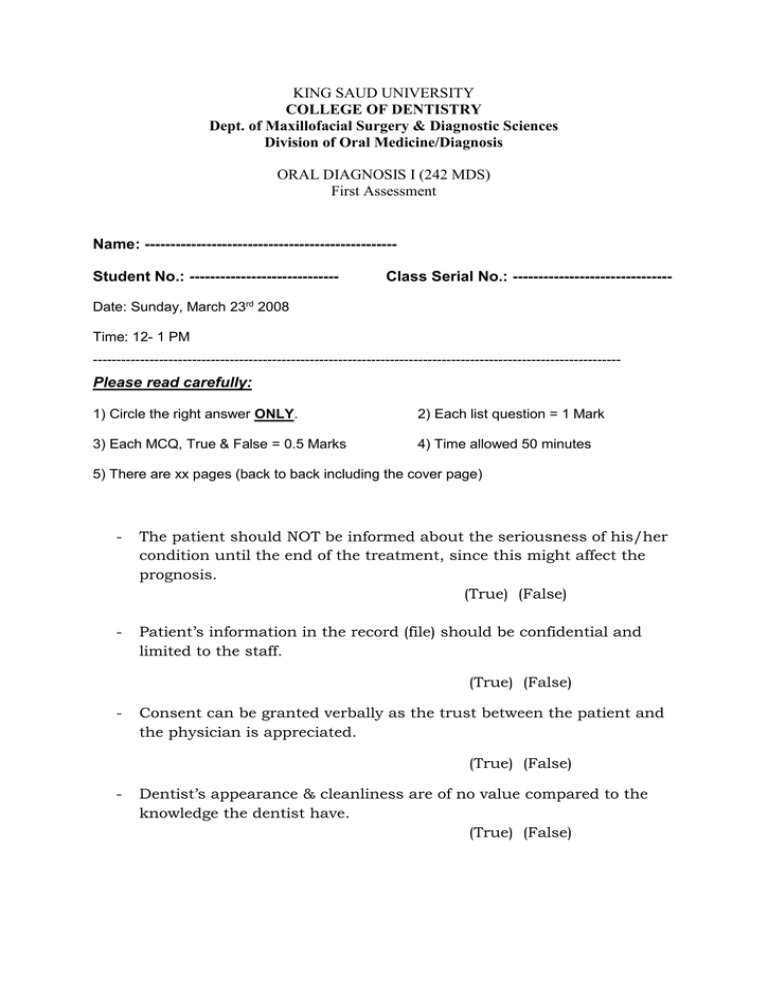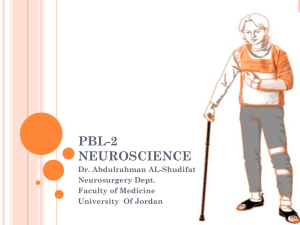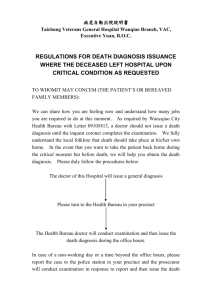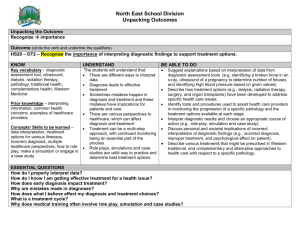242-1st Assessment
advertisement

KING SAUD UNIVERSITY COLLEGE OF DENTISTRY Dept. of Maxillofacial Surgery & Diagnostic Sciences Division of Oral Medicine/Diagnosis ORAL DIAGNOSIS I (242 MDS) First Assessment Name: ------------------------------------------------Student No.: ----------------------------- Class Serial No.: ------------------------------- Date: Sunday, March 23rd 2008 Time: 12- 1 PM ---------------------------------------------------------------------------------------------------------------- Please read carefully: 1) Circle the right answer ONLY. 2) Each list question = 1 Mark 3) Each MCQ, True & False = 0.5 Marks 4) Time allowed 50 minutes 5) There are xx pages (back to back including the cover page) - The patient should NOT be informed about the seriousness of his/her condition until the end of the treatment, since this might affect the prognosis. (True) (False) - Patient’s information in the record (file) should be confidential and limited to the staff. (True) (False) - Consent can be granted verbally as the trust between the patient and the physician is appreciated. (True) (False) - Dentist’s appearance & cleanliness are of no value compared to the knowledge the dentist have. (True) (False) - When do you change gloves in the dental clinic? Give two reasons. a) ____________________________________________ b) ____________________________________________ - Which one of these items is correct regarding facemask? It should be: a) b) c) d) Worn after wearing gloves to ensure cleanliness of the mask. Changed every 2 hours. A new mask should be worn for every patient. Adjusted during dental procedures to ensure fitness. - Regarding your hands in infection control? a) b) c) d) Hot water should be used to wash hands for better cleanliness. Wash hand for 2 minutes whenever gloves are changed. Wash hand for 2 minutes at the beginning & end of the session. Disinfect hands with chlorohexidine gluconate. - Which one of these reasons is the primary goal of infection control in dentistry? It is to reduce the risk of cross contamination between --- a) b) c) d) - Patients and dental instruments. Dental students. Dental patients. Patients and dental care providers. As regard to the protective gowns, which of the following is correct? a) It should be medium level b) It can permit blood & saliva to go through, since they are clothes below. c) One should not use clothing that is pulled over the head. d) a & b. e) a & c f) All of the above - What is the unwanted side effect of gloves? ............................................................................................. a. b. c. d. e. - Examination gloves are the most commonly used gloves because: Least inexpensive. They are sterile. They have the best fit. None of the above. All of the above. Name one disease that is transmitted by Inoculation and one by Inhalation? ................................................................................................. ................................................................................................. - The purpose of diagnosis is to be able to offer the followings: a) b) c) d) An effective and safe treatment. A cheap dental treatment. An accurate prognostication. After treatment services. - Diagnosis: Is the process of evaluating the patient’s health, as well as the resulting opinions formulated by the clinician. (True) (False) - The most effective approach to reach to a diagnosis is by applying: a) b) c) d) Scientific Scientific Scientific Scientific - During collecting information from the patient, the clinician should stay objective with regard to his decision. methods methods methods methods to to to to advanced treatments. clinical decisions. better prognosis. patients’ history. (True) (False) - List the four steps of the Diagnostic Method: 1- ---------------------------------------------------------------------2- ----------------------------------------------------------------------3- ----------------------------------------------------------------------4- ----------------------------------------------------------------------- - Collection of information is the diagnostic data base, which consists of: a) b) c) d) Patient History Physical Examination Adjunctive diagnostic Procedures All of the above - To evaluate the accuracy of information collected, the clinician may: a) b) c) d) Interview the rest of the family Request laboratory tests Send the patient to another physician Prescribe analgesics - Diagnostic Decision: is a hypothesis that may be correct OR wrong (True) (False) - Comparing the collected information of the disease with other diseases (producing the same abnormality) will lead to: a) b) c) d) Definitive diagnosis Differential diagnosis Definitive treatment Different diagnostic method - Testing the (diagnostic decision) hypothesis, the clinician will need to re-assess the case by: a) b) c) d) e) Re-appoint the patient Requesting an additional tests Predict response by trying an appropriate treatment All of the above b & c only - List the types of the clinical examinations: 1- ------------------------------------------------------------------2- ------------------------------------------------------------------3- ------------------------------------------------------------------4- ------------------------------------------------------------------5- ------------------------------------------------------------------- - “To identify the condition that have changed in comprehensive examination” a) b) c) d) Re-call diagnosis Emergency diagnosis Comprehensive diagnosis SOAP - Which one of these items is the aim of patient recall examination? a) b) c) d) It It It It is is is is to to to to review the effect of the treatment given redo the treatment plan redo patient's history update the personal data - Which item is not correct regarding the diagnostic method? a) b) c) d) e) Organizing the clinical information Determination of clinical significance of findings Comparing the findings with the knowledge and experience Correlation of the unusual findings Taking patient's history - “Indicated if consultation is requested” a) b) c) d) Re-call diagnosis Emergency diagnosis Comprehensive diagnosis SOAP - “Includes Intra & Extra oral examination + adjunctive procedures” a) b) c) d) Re-call diagnosis Emergency diagnosis Comprehensive diagnosis SOAP - Define the followings :- a) Indurated base ---------------------------------------------------------b) Doughy ------------------------------------------------------------------c) Pitting---------------------------------------------------------------------d) Thrill----------------------------------------------------------------------- Passive visual examination referred to as inspection is accomplished by the clinician while the patient is in active state (True) (False) - Palpation is the physical examination method that relies on the sense of touch. Bimanual (using 2 fingers of one hand ) or bidigital (using both hands ) (True) (False) - Pulp testing can be done by: a) -------------------------------------------------------------b) --------------------------------------------------------------c) --------------------------------------------------------------d) --------------------------------------------------------------- - Visual examination by dentist needs: a) --------------------------------------------------------------b) --------------------------------------------------------------c) --------------------------------------------------------------d) ----------------------------------------------------------------- - Perapical pathosis can be detected by: a) b) c) d) Percussion of teeth vertically Percussion of teeth horizontally Palpation Mobility - Carious lesion is identified by the sensation known as: a) b) c) d) Fremitus Bruit Catch Murmur - Pocket depth is measured with slender sharp periodontal probe (True) (False) - Aspiration is an attempt to remove material from compressible soft lesion or abnormality within bone (True) (False) - Radiographic examination is an adjunctive diagnostic methods for the following except: a) b) c) d) Periodontitis Non-dental jaw lesions Periapical infection Aphthus ulcers - What part of the patient history should include history of previous diagnosis, consultation and treatment, in connection with the chief complaint? a) b) c) d) Past dental history Past medical history Personal history History of the chief complaint - Why are hepatitis, jaundice and tuberculosis important part in the case history? Because they: a) b) c) d) Affect the past dental history. Affect the diagnosis of the chief complaint. Require special precaution. Affect the treatment plan. List two reasons for reviewing systems during patient history. 1. _______________________________________________ 2. _______________________________________________ - Which one of the followings is not a correct reason for obtaining (taking) case history? a) It helps evaluate the psychologic make up of the patient. b) It alerts the dentist to the need of special precautions. c) It gives complete information about the medical history of family members. d) It aids arriving at a tentative diagnosis. - What does the term indurated used to explain: a) Compressible tissue b) Firmness c) Features of benign tissue Features of malignant tissue - Mark the correct answer: (Symptoms are subjective features described by the patient during clinical interview). (Signs are objective findings observed by the clinician during clinical examination). a) b) c) d) Both statements are correct. Both statements are incorrect. The first statement is correct & the second is incorrect. The first statement is incorrect & the second is correct. - Which one of these items is NOT correct regarding family history? a) b) c) d) It identifies diseases in other members of the family. It identifies presence or absence of communicable disease. It declares presence or absence of hereditary diseases. It isolates case of potential cardiovascular diseases in family members. - What does signs and symptoms of cancer includes? a) Weight gain b) Normal function of the part affected c) Weakness d) Normal blood count - What is the average normal pulse in adults? a) b) c) d) 80-120 beats/min. 12-20 beats/min. 60-90 beats/min. 40-60 beats/min - Match the following description with the proper medical terms. Write the number opposite the term. i. ii. iii. iv. Shortness of breathe ____ Difficulty in swallowing ____ Abnormal heart rate ____ Increase thirst ____ Terms 1. 2. 3. 4. 5. 6. 7. 8. 9. 10. 11. Asthma Cyanosis Polydipsia Angina pectoris Dyspnia Arythmia Heart burn Hemoptysis Dysphagia Tachycardia Polyphagia - What is NOT correct regarding signs or symptoms of hepatitis? a) b) c) d) Increase appetite Jaundice Anorexia Nausea - What characteristics are gained by palpation? a) b) c) d) Compressibility and tenderness Redness and discoloration Vitality and function Symmetry and contour - Which statement is correct? (Stable angina is episodic chest pain on exertion). (Unstable angina is frequent chest pain, spontaneous & persists at rest). a) b) c) d) Both statements are correct. Both statements are incorrect. The first statement is correct & the second is incorrect. The first statement is incorrect & the second is correct. - What is the term used to describe minimal or moderate resistance that slowly regains the original contour after release of pressure? a) b) c) d) Indurated Spongy Pitting Doughy - Auscultation without enhancement can be used: a) To listen to patient taking deep breath b) If a patient has respiratory obstruction c) To detect TMJ sound d) a & b e) a, b & c






